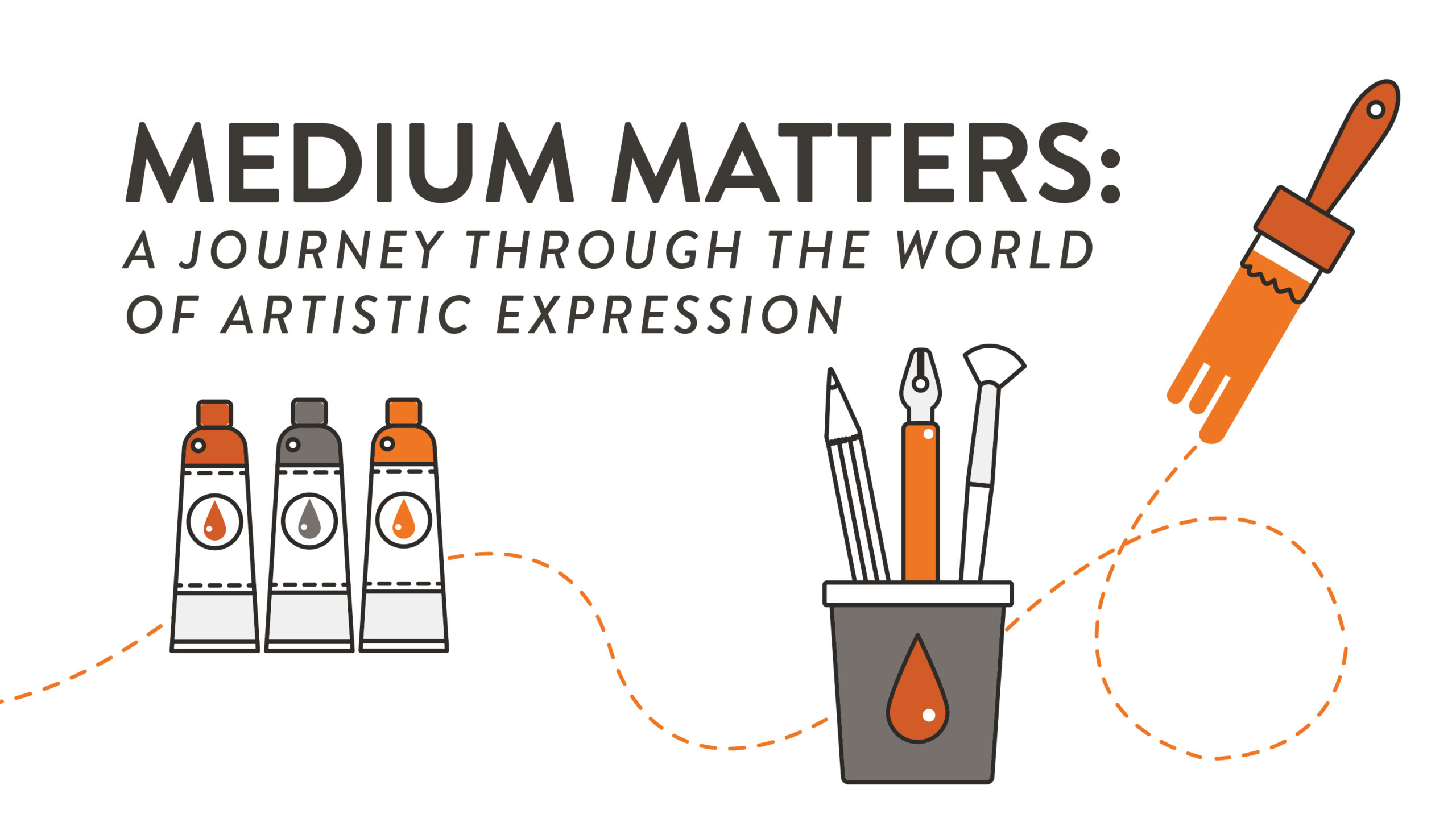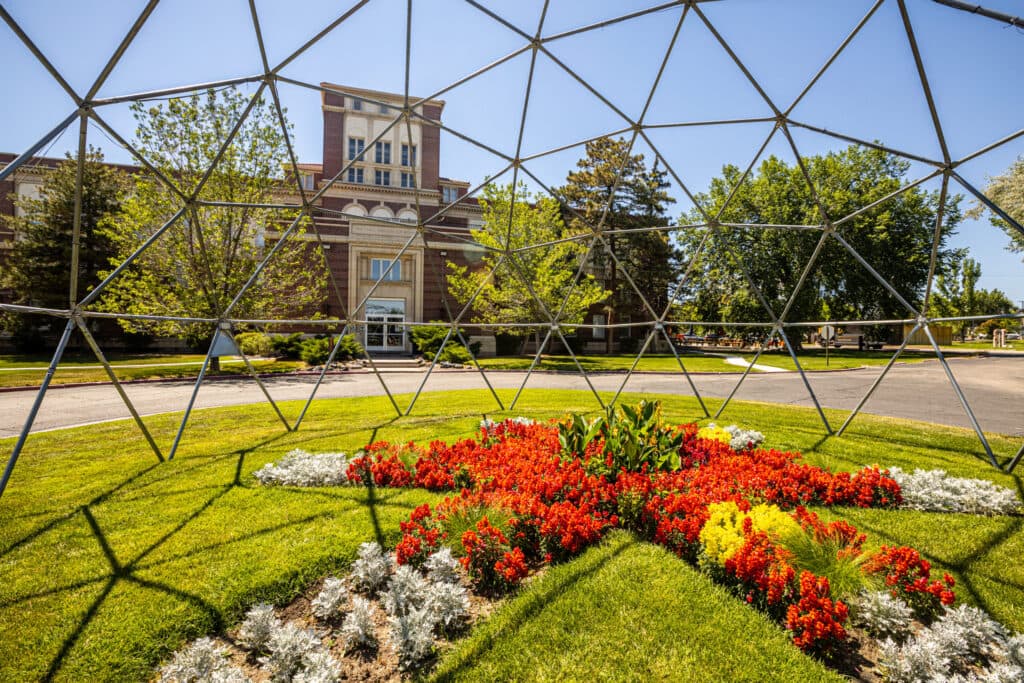Do you have a favorite art medium? Perhaps you prefer the hands-on application of oil painting compared to the modern age of digital drawing. Whatever your interests are, it’s important to know that artists have been expressing themselves through a wide variety of disciplines and art mediums for centuries. In fact, most artists work with multiple art mediums allowing them to learn different techniques, be flexible in the workforce, and even cure artist’s block, according to Vision Stash.
In this blog post, we will explore different mediums of art, their evolution throughout history, and how they influence artistic expression. We will also provide you with insights on how to choose the right art medium for your creative journey.
What are the Mediums of Art?
According to Minted, “ A ‘medium’ can refer to the materials used to make a work of art (such as clay, wood, paint, fabric, charcoal, etc.) and also refer to creation techniques such as sculpture, printmaking, watercolor, or pottery.”
Mediums often fall in and out of popularity over time, allowing versatile artists to thrive in mastering multiple mediums using various materials. Some of the most popular mediums in the modern era include animation, digital art, and game art. Each medium offers unique possibilities for artistic expression and contributes to the overall aesthetic and style of the artwork.
How Mediums Shape Artistic Styles
Different art mediums have distinct qualities that influence the style and technique used by artists. For example, the fine lines and precise detailing achieved with pencils and graphite often result in realistic and detailed drawings. On the other hand, the bold and vibrant colors of oil painting can evoke a sense of depth and emotion. The choice of medium can also influence the overall texture, form, and visual impact of the artwork. By understanding the characteristics of different mediums, artists can explore new avenues of artistic expression and develop their unique style.
Evolution of Art Mediums:
It’s no secret that art mediums are evolving constantly. Whether they are reflecting the cultural and technological advancements of the era or simply becoming more (or less) popular, all mediums have gone through quite the evolution. Let’s explore two of the biggest eras in art history and how they have impacted the art and design industry.
- Renaissance Era and Its Influence – According to Artchive, “The cornerstone of Renaissance art was classical antiquity, considered to be the most noble of all historical traditions.” The Renaissance era witnessed a significant shift in art mediums back to classic learning and wisdom. In fact, the Renaissance, meaning “rebirth” in French, has led to the rise of some of the greatest artists in history. Artists like Leonardo da Vinci and Michelangelo explored new techniques in painting and sculpture using oil paints and marble to create works that are respected globally. These innovations allowed for greater realism, detail, and depth in artworks. The Renaissance period sparked a renewed interest in the human form and natural world, which influenced artistic styles for centuries to come.
- Modern Era – In the modern era, artists began experimenting with new materials and techniques. The invention of photography, with the first photo being taken in 1826, brought a revolutionary change to the art world. Artists like Pablo Picasso explored new ways to convey emotions and ideas through unconventional mediums and techniques. The modern era marked a departure from traditional artistic styles, giving artists the freedom to push boundaries and move away from the rebirth of the classics.
Traditional Mediums
Traditional mediums have stood the test of time and continue to be widely used by artists around the world. From museums to local art markets, artists continue to present traditional works such as oil paintings, paper drawings, and pottery. Let’s explore a few of the top traditional mediums:
Pencils and Graphite
Perhaps the first art tool you were introduced to as a child, graphite pencils are commonly used in the writing, drawing, and sketching mediums. Artists can create intricate details and shading with varying degrees of hardness from a wide range of tones, from light to dark. According to Artdex, graphite pencils have been used in different art mediums since 17th century France.
Oil Painting
Considered a beginner-friendly medium, oil painting is a classic medium that offers rich, vibrant colors in its results. From Vincent van Gogh’s “The Starry Night” to the “Mona Lisa” by Leonardo da Vinci, these works might be what people imagine when thinking of famous oil paintings.
The slow drying time of oil paints allows for blending, layering, and achieving a wide range of textures. Artists can create depth and intensity in their paintings using different brush strokes and techniques, resulting in visually stunning and dynamic artworks.
Clay and Pottery
Clay and pottery have been used for centuries to create functional and decorative objects. This malleable medium focuses on sculpting and molding, allowing artists to work with their hands while making art that is practical. The art of pottery involves shaping the clay on a wheel, firing it in a kiln, and applying various glazes to achieve different colors and finishes.
Metal Sculpture
Metal sculpture involves working with various metals, such as bronze, steel, or copper,
to create three-dimensional artworks. Metal offers durability and versatility, allowing
artists to create intricate and dynamic sculptures. Metal sculpture often requires
welding, casting, or forging techniques, making it a challenging yet rewarding medium
for artists.
Contemporary & Digital Mediums
With the exponential rise in popularity of computers, phones, and tablets, contemporary and digital mediums are making their mark on many organizations around the world. Using various materials in the digital space, artists can make these mediums work at an affordable cost rather than buying physical material. Let’s explore some of the top contemporary and digital mediums.
3D Modeling
3D modeling utilizes computer software to create three-dimensional virtual models. This medium is used in various industries, including animation, game art, and product design. Artists can manipulate digital objects in a virtual environment, bringing their ideas to life through a variety of different roles.
Digital Painting
“Digital art is becoming increasingly popular, as it offers artists a lot of freedom and flexibility. It’s also easy to share digital art online, which has helped to increase its popularity,” explains Fine Art Tutorials. Digital painting allows artists to create artworks using digital brushes and software. It offers a wide range of tools, layers, and effects, enabling artists to experiment with different styles and techniques. Digital painting provides the flexibility of undoing mistakes, quickly experimenting with color palettes, and easily sharing artwork in a digital format.
Photography
One of the most popular digital mediums today, photography captures moments, emotions, and narratives through the lens of a camera. From smartphones to mirrorless cameras, digital cameras have become widely accessible, allowing photographers to experiment with different techniques, lighting, and composition. The photography medium offers a unique perspective on the world, and photographers can use post-processing software to enhance and manipulate their images further, blending the medium with digital art.
Mixed Media
Mixed media combines various art mediums and materials to create unique and layered artworks. Artists can combine painting, drawing, printmaking, collage, and more to create visually dynamic and thought-provoking pieces. Mixed media allows for experimentation, pushing the boundaries of traditional artistic techniques.
Unconventional/Experimental Mediums
What would art be without those pushing the status quo of what it means to be an artist? Enter the unconventional and experimental mediums. From performance and installation art to printmaking and calligraphy, these are great introductory mediums that challenge artists to find the uniqueness and purpose behind their work.
Calligraphy/Lettering
Calligraphy and lettering focus on the art of beautifully crafted writing. Artists use specialized tools like nibs, pens, and brushes to create elegant and expressive letterforms.
According to Cult Pens, calligraphy first appeared around 600BC, making this medium one of the oldest of its kind. Calligraphy and lettering can be seen in various forms, from decorative lettering in artwork to expressive scripts on signage or wedding invitations.
Performance and Installation Art
From live performances to thought-provoking installations, performance and installation art blur the lines between art and life. These mediums involve creating immersive experiences, often for audiences, incorporating elements like sound and movement. Artists challenge conventional notions of art by transforming spaces and engaging viewers in thought-provoking and interactive experiences.
Printmaking
Printmaking involves creating multiple copies of an artwork through processes like etching, relief printing, or lithography. Artists use specialized tools, plates, and presses to transfer ink onto various surfaces like paper or fabric. Printmaking allows artists to experiment with textures, colors, and layers, resulting in unique and reproducible artworks.
Students at Rocky Mountain College of Art + Design use several resources for print making on campus. From 3D printing in the FabLab to high-quality photo prints in the Rude Building, there are certainly many options for printmaking as a student.
How to Choose Your Art Medium?
Now that you understand the medium art definition and have explored a variety of different media, how do you choose the right art medium for you? Choosing the right art medium depends on various factors, including your interests, skills, resources, and artistic goals. Consider if you are just a hobbyist or looking to turn your passion into a profession. Here are some considerations to help you choose your art medium:
Whether you choose digital art or clay and pottery, being interested in the medium helps build consistency and skill. Speaking of skill, identify what comes easiest to you in different techniques and mediums. Consider whether you want to build upon your existing skills or explore new mediums to challenge yourself. Don’t be afraid to try out different mediums to discover which ones resonate with you. Whether you attend a local art event, or enroll in classes, exploring what works for you can be beneficial to your career long term.
Inspiration
Look at the works of artists who specialize in different mediums. Study their techniques, styles, and use of materials to gain insights and inspiration for your own artistic journey. Remember, choosing the right art medium is a personal decision that requires self-reflection, experimentation, and a willingness to explore new possibilities. Your chosen medium should align with your artistic vision and provide a platform for self-expression and creative growth.
Ready to Take Your Art Medium to New Heights?
Now that you have a baseline understanding of the many art mediums available to learn, take the first step into putting your knowledge into practice by exploring RMCAD’s online and on-campus degree programs today.

